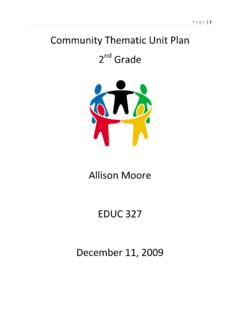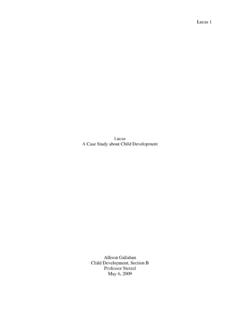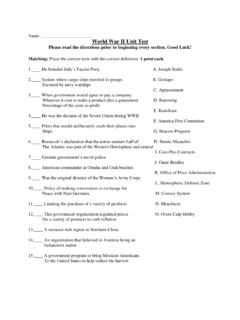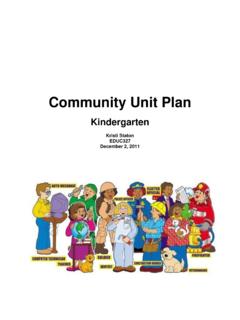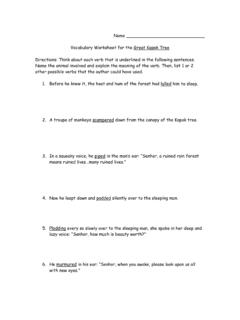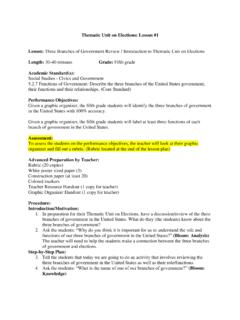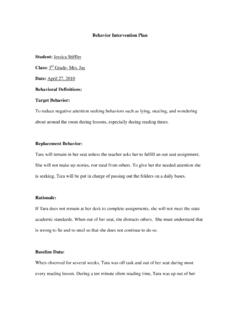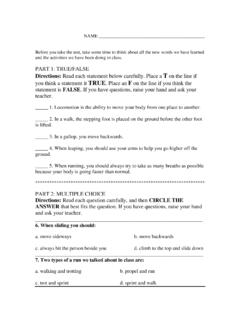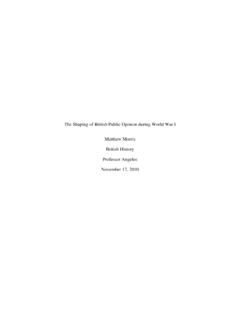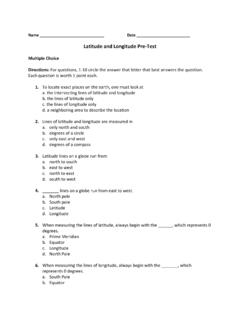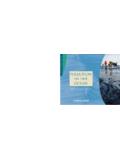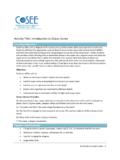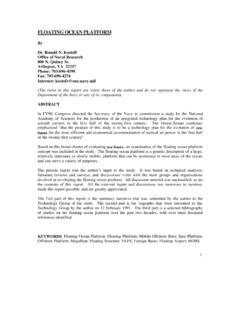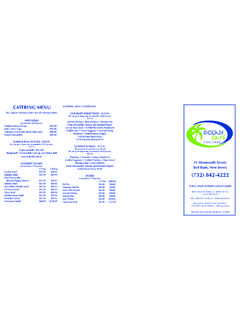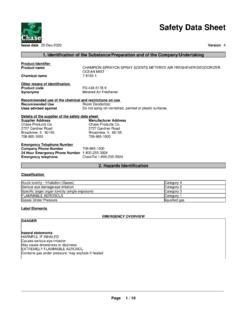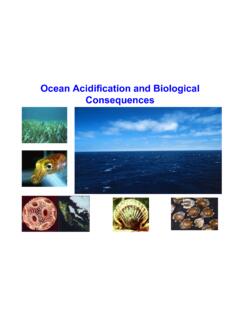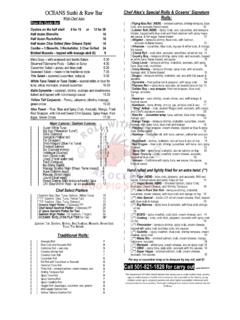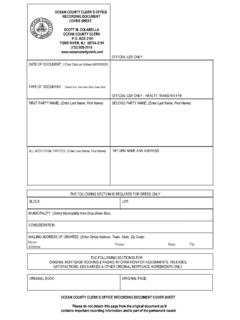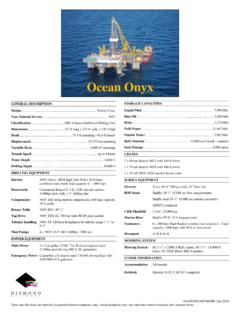Transcription of Ocean Unit Kindergarten - Manchester University
1 Ocean unit Kindergarten Whitney Whitehair EDUC 327 December 10th 2009 1 | Page Table of Contents Introductory sheet Pages 3-7 Standards Pages 7-8 Curriculum map Page 9 Letter to parents Page 10 Trade books Pages 11-12 Bulletin Board Pages 12-13 Field trip/guest speaker Page 14 Pre-test/Post-test Pages 15-18 Technology & literaturePage 19 Lesson Plans Pages 20-62 2 | Page Introductory Sheet Grade Level and Typical Learner Science is directed at the five and six year olds in the Kindergarten Indiana State standards by making the curriculum developmentally age appropriate.
2 It is very important to provide developmentally appropriate content through the age level in both the cognitive and physical learning styles. A report from the National Education for Young Children (NAEFC) provides teachers with a significant description on the appropriate development of children that states, Most five-year-olds can begin to combine simple ideas into more complex relations. They have a growing memory capacity and fine motor physical skills. They have a growing interest in the functional aspects of written language, such as recognizing meaningful words and trying to write their names (NAEYC 1986). They need an environment rich in printed materials that stimulates the development of language and literacy skills in a meaningful context.
3 They also need a variety of direct experiences to develop cognitively, physically, emotionally, and socially. Since five-year-olds come to school with an interest in the community and the world outside their own, curriculum can expand beyond the child s immediate experience of self, home, and family (NAEYC 1986). Six-year-olds are active learners and demonstrate considerable verbal ability. They are interested in games and rules and develop concepts and problem-solving skills from these experiences. Hands-on activity and experimentation are necessary for this age group (NAEYC 1986). Seven-year-olds become increasingly able to reason, listen to others, and show social give-and-take.
4 3 | Page Spatial relationships and time concepts are difficult for them to perceive. Flexibility, open-mindedness, and tolerance of unfamiliar ideas essential in social studies are formed to a remarkable extent by the interactions of the four- to eight-year-olds (Joyce 1970). Eight-year-olds combine great curiosity with increased social interest. They are able to learn about people who live elsewhere in the world. During these early grades, children can learn from the symbolic experiences of reading books and listening to stories; however, their understanding of what they read is based on their ability to relate the written word to their own experience (NAEYC 1986).
5 NCSS Board of Directors. (1988, June). Social studies for early childhood and elementary school children preparing for the 21st century. Retrieved from Rationale Why do students need to participate in this unit of study? Kindergartener s main focus according to the state standards is incorporating the unit of the Ocean through the idea that Living and Learning Together should be an area of study. Students focus upon their immediate environment, and stress is placed on social and civic learning experiences, including interaction with peers and respect for others. This unit on oceans is very broad and can be used to incorporate many subject areas, not just science.
6 Even though Indiana is not a state that is surrounded by an Ocean , this unit should still be taught in the classroom (as seen in the standards). Students need to participate in activities that are meeting the standards. This Ocean unit helps students focus on their environment and its many differences. Students will gain the opportunity to get an inside look at how living and learning together impacts things such as our Ocean . 4 | Page Goals I want to strive for the parents to get involved in the unit , whether it is with helping out in the classroom or providing additional materials to supplement our unit . My student s ideal field trip would be to end the unit by visiting an aquarium.
7 My goal is for them to make an end connection with everything we have been learning in the unit . (May not happen this time, but if I use the unit in the future, this would be a goal for this unit plan. I would like the students to overall to enjoy this unit . I want to engage them as much as possible so it is a unit that they will always remember. It is a goal to somehow survey what they liked and did not like so I can alter the unit in the future. I have a goal of my classroom that behavior-wise I can control the focus on the unit through manipulative and hands on experiences. I want by the end of the unit for the kindergarteners to individually tell me at least 5 things they learned from the unit .)
8 I think that being able to explain this to me as a teacher through this unit . I want to make it fun learning so that they do not actually know they are learning. Learning Objectives SC=SCIENCE; SS=SOCIAL STUDIES; M=MATH; R=READING; W=WRITING; E=ENGLISH; D=DRAMA; MU=MUSIC; PE=PHYSICAL EDUCATION; A=ART LESSON ONE SS Given 4 assessment problems, students will identify maps and globes as a class for a way of representing Earth and identify map symbols for land and water at the end of the lesson with 75 % (3 of the 4). LESSON TWO M /SC Given a ruler, the student will recognize which whale is longer or shorter with 66% accuracy.
9 (2 of the 3 measurements) LESSON THREE SC K. 1 Given 6 toys and a tub of water, students will identify which items float or sank with 83 % accuracy. (5 out of 6) SC Given a journal, students will identify compare 3 similarities and differences in families, classmates, neighbors to other living creatures that can swim with 66% accuracy. (2 out of 3) 5 | Page LESSON FOUR R After reading the story, the students will describe 4 characteristics for each character in at least 3 of the 4 boxes. R K. 1 Using their assessment worksheet given, the students will orally explain the characteristics of both characters with 100% accuracy.
10 (100 percent meaning they explained both characters; 50 percent would be only one) LESSON FIVE W / SC Using pictures and words from Finding Nemo, students will identify the order of the beginning, middle, and end of the story with 66% accuracy. (10 of 15 points) LESSON SIX D SC After reading the Rainbow Fish and Finding Nemo, the student will pantomime a plant or animal without using words 100 percent of the time. LESSON SEVEN A SC Given watercolors and art materials, the student will re-create an animal from the Ocean with 100 percent completion. LESSON EIGHT PE SC oral commands, the student will perform gross motor skills across the gym with 63% accuracy.
